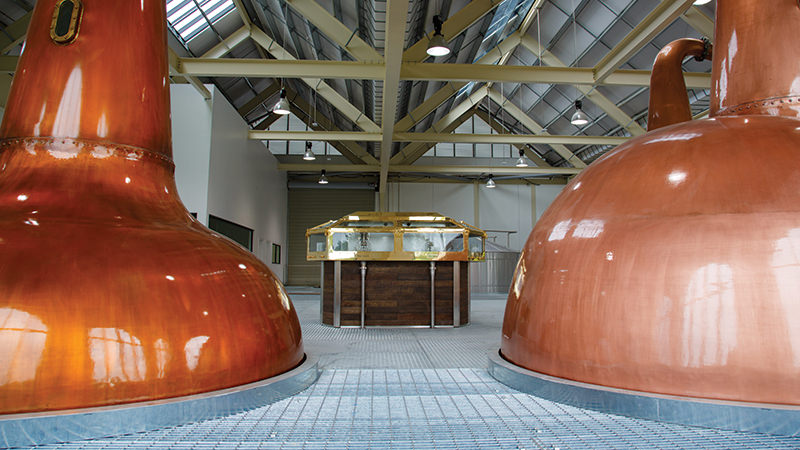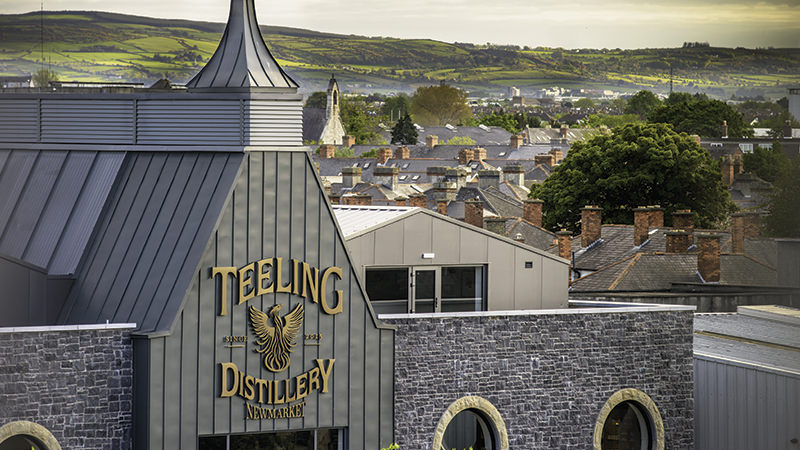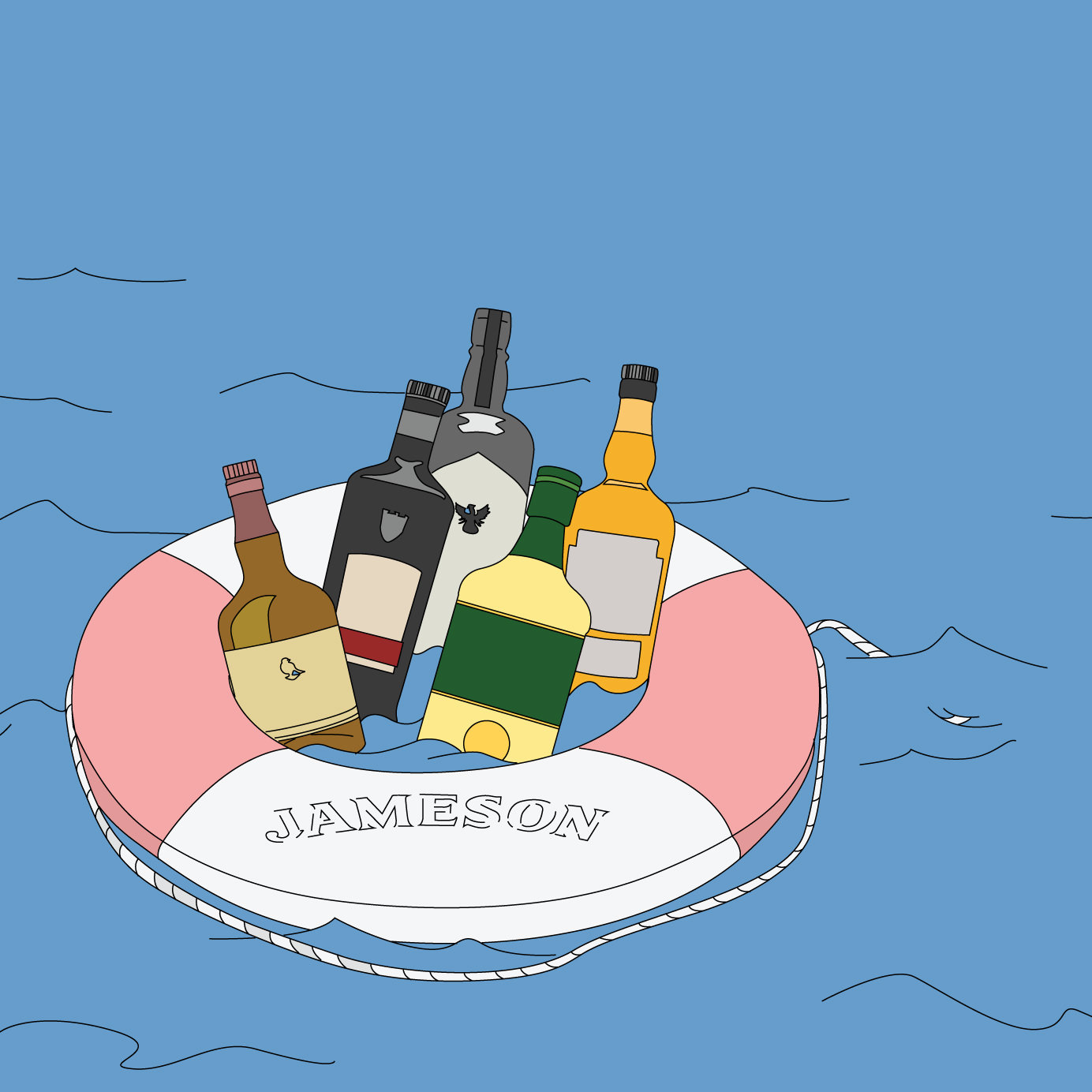People who say that success is a double-edged sword probably haven’t struggled to pay rent in a while. Still, certain gravy trains have their drawbacks.
Take Jameson, the world’s most popular Irish whiskey. The brand moved 6.5 million cases last year and reported double- and triple-digit growth in 80 global markets in the latter half of 2017.
Of course, Jameson is no angel. Slurrily known as “Jamo” at sports bars and dimly lit taverns across the country, the spirit is, for some, synonymous with partying. It’s what hard-living Jimmy McNulty drinks on “The Wire.” Rihanna name-checks it in her 2010 song, “Cheers (Drink to That),” singing, “Cheers to the freakin’ weekend / I’ll drink to that / Let the Jameson sink in.”
The brand’s hell-raising reputation moves units and inspires loyalty, but it doesn’t exactly secure Irish whiskey a spot in the craft canon. Whereas Japanese whiskies and single-malt Scotches inspire hushed reverence in mahogany-paneled bars, many Americans associate Irish whiskey with shot specials. Even as bottles from Redbreast and Midleton rank among the world’s best whiskeys, public misperception is harder to crush than a Jamo hangover.
This is the Jameson effect, and it’s a complicated beast.

Jameson wasn’t born Jamo. Party whiskey is a relatively recent phenomenon. According to Jameson lore, its liquor was so revered that warring parties spared the distillery in the 1916 Easter Rising, a historic battle in Ireland’s independence from Great Britain.
“When you think about it, they had access to everything,” Jameson’s archivist Carol Quinn told Forbes. “Not a single drop of whiskey was touched.” (Other distillers, including one also named Jameson, did not fare as well.)
The next several decades were unkind to Irish whiskey. Historians blame British trade tariffs and the onset of American Prohibition for the category’s decline.
Mid-century conglomeratization derailed things further. “There was a monopoly with one company called Irish Distillers, Ltd.,” Stephen Teeling, sales and marketing director, Teeling Whiskey Co., says. Throughout the 1960s, Irish Distillers, Ltd. (IDL) acquired brands, amalgamated resources, and ultimately controlled all whiskey production, including Jameson.
By 1972, there were just two Irish whiskey distilleries: Bushmills, in Northern Ireland, and Midleton, near Cork, Ireland. IDL owned both.
In 1988, French conglomerate Pernod Ricard acquired IDL. (One independent operation opened in Ireland in the interim. John Teeling, Stephen’s father, launched Cooley Distillery in 1987.)
“[IDL]’s main business was in cheap blends, well made but not very exciting,” cocktail historian David Wondrich writes in Esquire. Overall sales were sluggish, but Pernod Ricard saw an opportunity.
The company positioned Jameson, IDL’s lightest blend, “not as Irish whiskey, or indeed as whiskey at all, but as what it was — a light, smooth, and pleasant drink that went down as easily in shots as it did mixed with ginger ale or anything else,” Wondrich writes.
Jameson was marketed to vodka and white rum fans (or, as they were known in the late 1980s, everyone), not whiskey aficionados. An easy-drinking, shot-ready legend was born.
Contemporary associations linking Irish whiskey to partying come directly from Jameson’s marketing strategy. “The brand is incredibly successful,” Paige Parness, senior brand manager, Tullamore DEW, says.
Tullamore DEW is one of several next-generation Irish whiskey distilleries that debuted in Ireland in the last decade. Jameson’s global success has in fact encouraged the launch and relaunch of such craft Irish whiskey labels as Kilbeggan, Slane, Teeling, and Tullamore DEW.
“There are about 32 working distilleries in Ireland now,” Parness says. Irish whiskey is reportedly the fastest-growing spirit in the world. But educating consumers about craft iterations and outmaneuvering the Jameson effect takes grit.
“I’m just back from two weeks in California doing events with the trade, trying to speak to the type of accounts of people that we’re actively targeting,” Teeling told us earlier this week. “Our master distiller and brand ambassador were also involved in a market blitz.” All told, the Teeling team hosted more than 250 Irish whiskey tasting seminars in two weeks.
Instead of competing with Jameson for space in sports bars, Teeling courts top American mixologists and attends conferences like Tales of the Cocktail and Bar Convent. His goal is to get the label in front of craft bourbon, Scotch, and cocktail enthusiasts in top bars.

Pam Wiznitzer, national president of the United States Bartenders’ Guild and creative director of NYC’s Seamstress bar, became enthusiastic about Irish whiskey when she was bartending at New York’s acclaimed Dead Rabbit.
“Irish whiskeys have these tropical fruit notes that are really cool,” Wiznitzer said in an interview in January. Slane, Wiznitzer’s preferred bottle, has “interesting finishing flavors because it’s aged in sherry casks,” she says.
Teeling’s line includes a small-batch whiskey matured in Central American rum barrels, and Tullamore DEW launched an expression aged in Demerara rum casks this week.
“We don’t push the shot as much as Jameson does,” Parness says. Instead, Tullamore DEW plays up its Irish heritage and celebrates whiskey as a sipping spirit.
“This younger generation has grown up with higher-end spirits,” Jenna Fagnan, president of Avión Tequila, a company that knows a thing or two about overcoming category stereotypes, says. “They are interested in provenance, in how it’s made, in the story behind it.”
Top-shelf tequilas provide a useful roadmap for Irish whiskeys looking to emerge from behind Jameson’s long shadow.
“What used to be known as the ‘spring-break, let’s-do-a-shot’ drink has now become an ultra-premium spirit meant to be sipped,” says Rande Gerber, co-founder of Casamigos Tequila. In June 2017, Gerber, George Clooney, and Mike Meldman sold Casamigos to Diageo for $1 billion. The company recently debuted a joven mezcal that retails for $59.99.
There are times when the only reason one needs to sloppily pour a whole bunch of drinks is that it’s the freakin’ weekend. But just as single-origin-agave tequilas and mezcals are different from bottom-shelf Margarita mixers, Irish whiskey is more nuanced than a shot you take while singing “Sweet Caroline.” Every party ends eventually.
